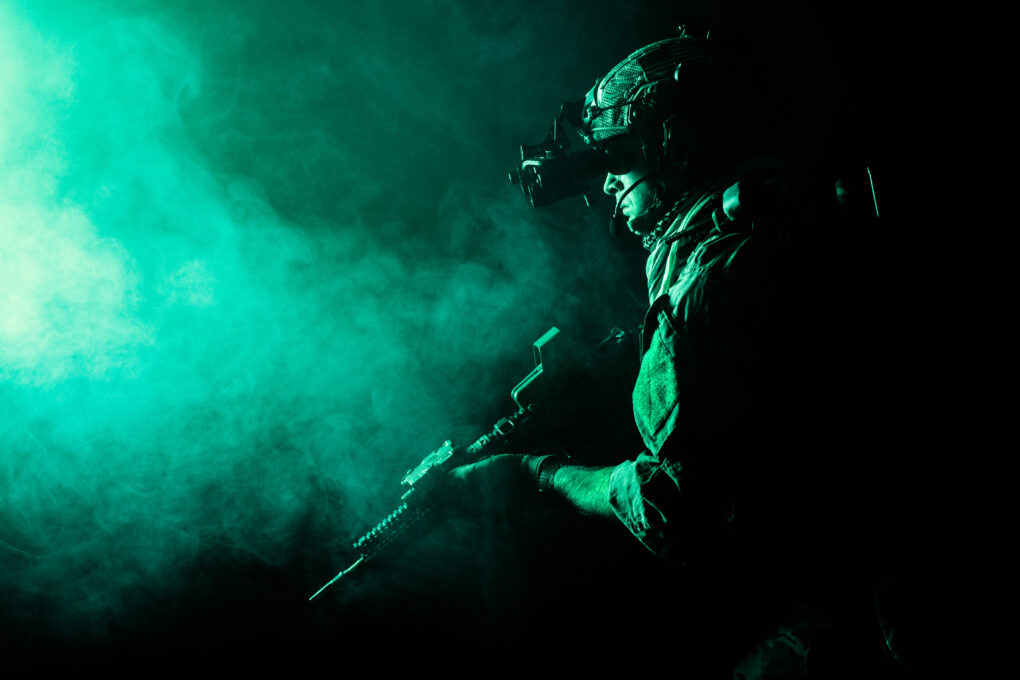Choosing between the DTNVS and the PVS-14 can feel like comparing a tank to a dirt bike; both can get the job done, but they’re built for different missions.
If you’re on the hunt for night vision devices for tactical use, hunting, or field operations, this post breaks down the real-world differences between these two top contenders. We’re talking weight, use cases, performance in the field, and of course, price.
Here at Steele Industries, we have a proven methodology to test and compare products in our inventory. Whether you’re a seasoned night vision user or just stepping into the world of NVGs, let’s figure out which one suits your style (and budget).
Quick Overview: DTNVS vs. PVS-14 at a Glance
| Feature | DTNVS | PVS-14 |
| Tube Type | Gen 3 | Gen 3 |
| Style | Binocular | Monocular |
| Weight | ~500g (without mount) | ~335g (without mount) |
| Phosphor Options | White | White |
| Manual Gain | No | Yes |
| Battery | 1x CR123 | 1× AA |
| Mounting | Helmet, handheld | Helmet, handheld, weapon |
| Price Range | $8,000+ | $3,500+ |
What’s the DTNVS?
The DTNVS (Dual-Tube Night Vision System) is the Cadillac of modern analog night vision. It offers dual Gen 3 tubes with articulation, meaning each pod can flip up independently, ideal for reducing snag hazards and keeping a low profile.
The skeletonized polymer construction offers a durable, lightweight package. Articulation and independent pod shutoff come standard, and the unit can also be equipped with IPD stops via an OEM bolt-on kit.
Why it’s a top pick:
- True depth perception from dual tubes
- Lightweight for a dual-system
- Articulating pods for comfort and field flexibility
- Battle-proven in tactical and professional environments
Use it if: You’re running night ops, law enforcement patrols, or military training where depth, awareness, and speed matter. The DTNVS is suitable for scenarios demanding a high degree of situational awareness and rapid movement in low-light conditions, such as nighttime operations, law enforcement patrols requiring swift responses, or military training exercises where maintaining formation and quickly identifying threats in a three-dimensional space are critical. Its design prioritizes depth perception, allowing users to better navigate complex environments and perceive distances accurately, which is essential for tasks requiring speed and coordinated movement.
What’s the PVS-14?
The PVS-14 is the Swiss Army knife of night vision. It’s a single-tube Gen 3 monocular that can be mounted on a helmet, handheld, or even attached to a rifle.
The PVS-14 is a widely used monocular NVD. With manual gain control and an onboard IR illuminator, the PVS-14 is feature-packed for the user looking for a “do it all” monocular. The polymer construction keeps the unit lightweight while offering superb durability and impact protection.
Why it’s still a fan favorite:
- Lightweight and ultra-flexible
- Affordable compared to dual-tube systems
- Compatible with several aftermarket accessories
- Great for first-time users and serious civilians alike
Use it if: You’re a hunter, rancher, patrol officer, or prepper who needs clear night vision without breaking the bank.
Field Use Comparison
DTNVS in Action:
Dual tubes = true depth perception. That means safer movement over uneven terrain, better spatial awareness, and easier target tracking in dynamic environments.
Perfect for: Law enforcement special units, Military teams, Serious tactical enthusiasts, Fast-moving field ops
The downside is price and commitment. It’s a premium tool with a premium tag and is usually overkill for casual use. However, if you want quality, the DTNVS is perfect for you.
PVS-14 in Action:
A go-anywhere monocular that’s easy to mount, easy to learn, and easy on your neck after long hours in the field.
Perfect for: Night hunting or navigation, Search and rescue volunteers, Rural law enforcement, Budget-conscious users who still need clarity and durability
You lose depth perception compared to dual-tubes, but you gain flexibility, weight savings, and extra room in your gear budget. It is beginner-friendly and so easy to use due to its lightweight monocular build.
Durability and Reliability
Both units are rugged, mil-spec, and field-tested but your build matters.
- DTNVS housings from trusted sources like ACT in Black offer robust performance in any condition.
- PVS-14 builds from Steele Industries are hand-assembled with mil-spec tubes and components and come with a solid warranty.
No matter which you choose, make sure you’re buying from a reputable dealer (hint: not eBay).
Price Breakdown
For beginners, a PVS-14 monocular ranges from $2,800 to $4,500, offering essential night vision capabilities. Professionals often opt for DTNVS dual-tube systems, which start at $7,500 and can exceed $9,500, providing superior depth perception and performance. The cost difference reflects the technology and specialized features of each device.
- PVS-14: From $2,800 to $4,500 depending on the tube.
- DTNVS: From $7,500 to $9,500+ depending on configuration, tubes, and housing.
Not sure if you need binocular clarity? Start with a PVS-14; you can always upgrade later once you’ve got some runtime under your belt.
Our Take: Which One Should You Choose?
Choose DTNVS if:
- You work in tactical/law enforcement/military operations
- You need depth perception for movement, vehicle ops, or team navigation
- You want the best clarity and immersion money can buy
Choose PVS-14 if:
- You’re on a budget but still want reliable Gen 3 performance
- You want a multi-role device for helmet, rifle, or handheld use
- You’re just starting out and want something simple, proven, and trusted
Tactical Quote from the Experts:
The DTNVS and the PVS-14 are both elite-tier night vision systems, but they serve different needs.
If you’re running solo patrols, hunting, or setting up a versatile home defense rig, the PVS-14 might be the smarter (and lighter) call. But if you’re leading a team-based movement or running fast-paced night operations, the DTNVS offers unparalleled performance in the dark.
Still unsure what’s best for your mission? Request a quote at Steele Industries. We don’t just stock night vision, we build it and stand behind every piece.
PVS-14 vs DTNVS FAQs
Can I upgrade from a PVS-14 to a DTNVS later?
Absolutely. Many users start with a PVS-14 and later move to dual tubes as their needs or budgets evolve. Your mounts and helmet setups are often still compatible.
Is depth perception that big of a deal?
For static use or basic navigation? Not always. But if you’re moving fast, clearing rooms, or operating in dynamic environments, depth perception from dual tubes is a huge asset.
Does the DTNVS require external battery packs?
It can run on a single CR123 battery or be paired with an external pack for extended missions (via a special adapter). Most serious users run an external pack for weight balance and longer runtime.
Is one better for civilians?
PVS-14 is often the better entry point for civilians. It’s affordable, flexible, and easier to operate solo. DTNVS is more of a high-end investment for users who know exactly what they need.


